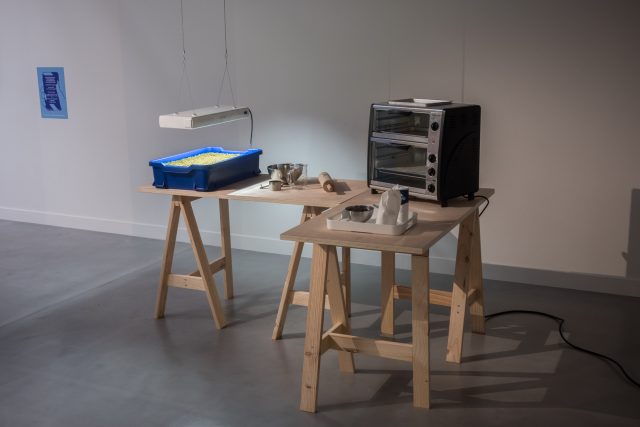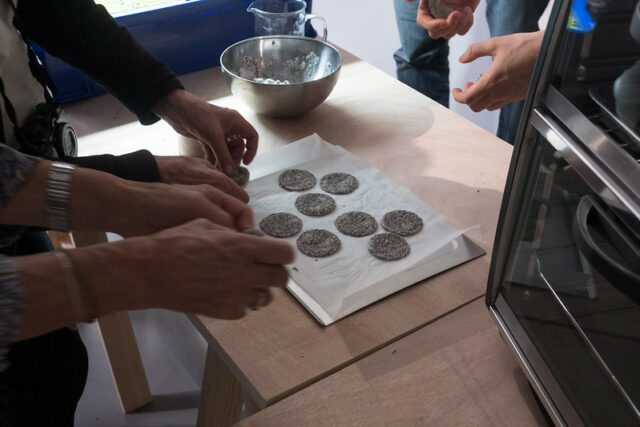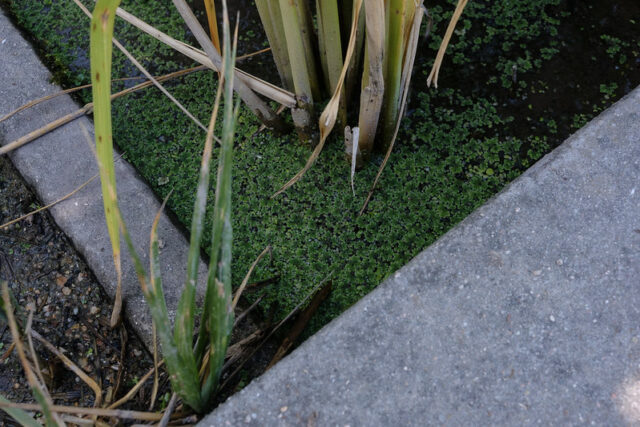The Azolla Cooking and Cultivation Project at Agoramania (2017)

[The Azolla Cooking and Cultivation Project at Agoramania 2017.]
During the Agoramania exhibition at MAIF Social Club in Paris (FR) artist and researcher Erik Sjödin cooked Azolla rice crackers together with the audience, using Azolla grown at Jardin des Plantes in Paris and rice flour from rice grown in the Camargue Region in France.
Azolla is not eaten today but because of it’s fast growth rate and nutritional content it has been suggested as a potential food stuff for settlements on Mars. Azolla does however have a long history of being used as a biofertilizer in rice paddies in Asia. By cooking and tasting Azolla rice crackers we explored if Azolla has potential to be used as a nutritional additive in rice based food such as rice crackers, rice bread, and rice noodles. Asides from nutrition and taste, if this is a good idea is assuming that Azolla does not contain any toxic substances, which might be the case but needs to be further researched.
As an intermission while the Azolla rice crackers were baking in the oven we watched a video message from philosopher Ségolène Guinard. For the production of this video message Ségolène Guinard visited the Jardin des Plantes in Paris, where the Azolla that was cooked and cultivated in the exhibition was acquired from. She also interviewed space agriculture researcher Masamichi Yamashita and biologist Francisco Carrapiço. In 2007, Yamashita et al. published the paper “Azolla as a Component of The Space Diet During Habitation on Mars”, which inspired Erik Sjödin to begin cooking and cultivating Azolla. Francisco Carrapiço work explores the implications of the water fern Azolla and its co-evolution with cyanobacterium for understanding and defining the notion of symbiosis. Yamashita’s and Carrapiço’s work are referenced in the publication The Azolla Cooking and Cultivation Project (Erik Sjödin, 2012), which they also helped review. In the video message, Ségolène Guinard reflects on the concept of symbiosis and its connections with different hypothesis such as symbiogenesis or endosymbiosis. An English translation of the script will be published here eventually.

[Cooking Azolla Rice Crackers at Agoramania 2017.]
The rice cakes turned out well. Crispy, round, and with a notable taste of Azolla. The audience who participated in the cooking agreed that they were pretty tasty. Below is the recipe we followed.
AZOLLA RICE CRACKERS
2 dl rice flour
8 tablespoons dried Azolla
1/2 teaspoon salt (with iodine)
8 tablespoons water
Mix the dry ingredients well.
Add water and kneed the ingredients into a dough.
Flatten out the dough and roll it out thin.
Cut out round crackers from the dough.
Bake the crackers in an oven at 180C for 8 minutes on each side.

[Azolla and rice at Jardin Des Plantes in Paris.]
The Azolla cultivated in the installation at Agoramania and dried and used for the cooking was grown at the Jardin des Plantes in Paris. There is no sign indicating where in the garden’s ponds Azolla is supposed to be growing, but Azolla can be found spread out in all the ponds. What is perhaps most interesting is that the Azolla, without intention from the gardeners, has found its way into the rice cultivation where it grows in the same manner as it does in rice paddies in Asia where it is used as a bio-fertilizer for rice. Azolla is not used as bio-fertiliser in rice cultivation in France today but, if Azolla wouldn’t risk becoming a problem as an invasive species, this shows that it would probably work well.
Thanks to Agoramnania / MAIF Social Club, Jardin des Plantes and Ségoléne Guinard.